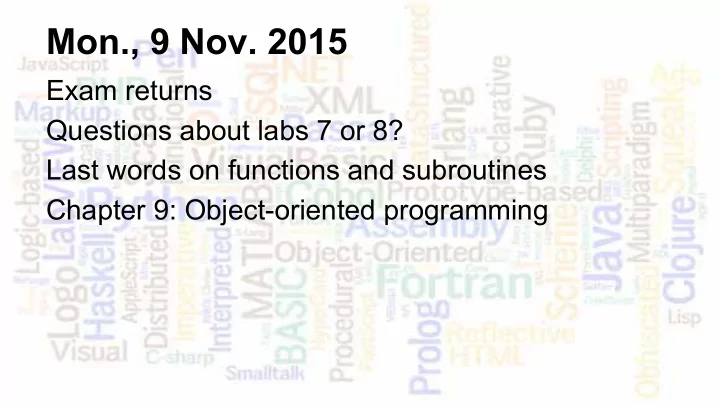

Mon., 9 Nov. 2015 Exam returns Questions about labs 7 or 8? Last words on functions and subroutines Chapter 9: Object-oriented programming
Last Words on Functions We’ve considered the following topics: ● Parameter passing (e.g., pass by value, pass by reference) ● Special syntax (default values, named parameters) ● Mechanisms for function calls (activation record stack, static and dynamic pointers, calling sequences) ● Parameter evaluation (applicative, normal, lazy) ● Closures ● Functions as first-class objects (lab 7) ● Exceptions
Last Words on Functions We didn’t cover: ● Generics (you have seen a lot of this in CMPSC 112) ● Events (we’ll revisit this topic in chapter 13) Let’s quickly visit one other topic: coroutines. A coroutine is a function that can be suspended and resumed; several coroutines can be active at once, transferring control back and forth between them.
Coroutines Coroutine A: Coroutine B: … ... transfer to B transfer to A … ... transfer to B transfer to A ... Coroutines are supported in languages such as Simula and Modula-2; useful for writing discrete event simulation code.
Generators in Python Many other languages have features that allow the implementation of coroutines (even if they are not “built in” to the language). Python has generator functions: >>> def gen99(): ... for i in range(100): ... yield i # NOTE: not “return i” >>> a = gen99() # call the function just once >>> next(a) 0 >>> next(a) 1
Generators in Python >>> next(a) 2 >>> for i in range(10): ... print next(a), ... 3 4 5 6 7 8 9 10 11 12 >>> for i in range(10): ... print next(a), ... 13 14 15 16 17 18 19 20 21 22
Generators in Python Several generators can be active at the same time; see sample program “gen.py” in the shared repository. This isn’t precisely a coroutine example (we don’t have “call” and “response” directly transferring back and forth). See https://docs.python.org/3/library/asyncio-task.html (“Tasks and coroutines”, Python 3.5 documentation)
Object Oriented Programming Important words: ● Encapsulation ● Inheritance ● Dynamic method binding (polymorphism)
Encapsulation Data and functions bound together into a single object. “Data hiding” -- hide implementation details from user. (More accurately, control access to data using public and private variables and methods.)
Inheritance Hierarchy of classes and objects. Shared behaviors and data--code re-use. Static polymorphism: one interface for many kinds of object.
Dynamic Method Binding An object’s methods are determined at runtime rather than compilation time, since subclasses can override methods and can be used wherever the superclass is allowed. (Example next time.)
Recommend
More recommend